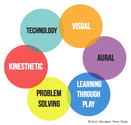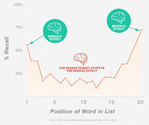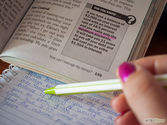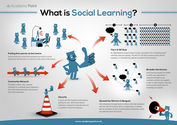-
About
- About Listly
- Community & Support
- Howto
- Chrome Extension
- Bookmarklet
- WordPress Plugin
- Listly Premium
- Privacy
- Terms
- DMCA Copyright
- © 2010-2025 Boomy Labs

 David James
David James
Listly by David James
Recall from long-term memory that is dependent on certain cues from our physical states.
Examples:
Useful resource: Training Your Brain to Learn Better (Even Without Drugs)
A technique for remembering long strings of information more easily by breaking it down into bite-sized pieces or "chunks" so that the brain can more easily digest the new information.
For example, a phone number sequence of 4-5-4-7-8-6-5 would be chunked into 454-7865.
Useful resource: The Science of “Chunking,” Working Memory, and How Pattern Recognition Fuels Creativity

A learning technique to increase intervals of time between revision of previously learned material.
Useful resource: How To Be A Smarter Learner By Using The Method Of Spaced Repetitions

The multi-modal learning premise is that the more ways in which you learn something (visually, aurally, kinesthetically , etc.), the more likely you are to remember it.
For example, MOOCs use a combination of videos, quizzes, assignments and forum community interaction to reinforce the material.
Useful resource: The 7 Styles of Learning Infographic

Top-down, or deductive learning, involves starting with the big picture—the overview—and breaking it down into component parts.
Bottom-up, or inductive learning, involves starting with the fundamentals—the basics—and assimilating into a more complex, big picture.
We learn more easily by understanding our learning preference for top-down or bottom-up. However, combining the two approaches and using them dependent on the context of what we're learning will optimize their value.
Useful resource: Khan Academy Bottom-up vs. Top-down processing

Metacognition is a term used by psychologists to describe the way we assess our strengths and weaknesses as learners.
When we recognize the limit of our knowledge or ability, we can then explore ways to expand and extend it. Proactively monitoring our learning strategies helps prepare us for new learning challenges..
Useful resource: Metacognition: The Gift That Keeps Giving

The order in which information is learned determines how reliably it will be recalled.
When you watch a presentation, have you ever noticed you can more easily remember the beginning and the end? We can use the same technique to help our learning. By organizing the most important facts and theories at the beginning of our study periods and then revising them at the end, we are more likely to remember the information.
Useful resource: Khan Academy Social perception - primacy recency

Instead of trying to remember information verbatim, i.e. word-for-word, paraphrasing or summarizing the important concepts and facts in our own words can greatly enhance our ability to recall them later.
Useful resource: [PDF] Why is the Meaning of a Sentence Better Remembered Than its Form? An fMRI Study on the Role of Novelty-Encoding Processes J. Poppenk, G. Walia, A.R. McIntosh,2 M.F. Joanisse,1 D. Klein,3 and S. Kohler
(Note from source: "The following PDF files are provided for academic use only. By downloading these files you agree to respect the copyrights therein.")

Princeton Professor and psychologist George Miller wrote a highly cited paper titled "The Magical Number Seven, Plus or Minus Two: Some Limits on Our Capacity for Processing Information" that states the number of objects an average person can hold in working memory is about seven.
If we apply "Miller's Law" to learning, then we maximize our learning capacity while avoiding mental overflow by limiting the number of topics we're trying to learn at any one time.
Useful resource: Washington Post article honoring George Miller

Dating back to ancient Rome and Greece, the Method of Loci is a mnemonic device that places information in context of visualizations of physical places to aid memory recall.
The Method of Loci is based on the premise that it's easier to remember things when we mentally attach them to items or places. The more detailed the mental image, the stronger will be the association.
Memory contest champions claim to use this technique to recall information such as digits, lists of words, and people's faces.
Useful resource: Book Outline - Remember Everything You Want and Manage the Rest

Learning doesn't have to be a "loner" experience.
Russian psychologist Lev Vygotsky suggested that knowledge is constructed through our interactions with others.
MOOCs (Massive Open Online Learning) leverage our inherent social needs by bringing people together to learn the same material in a virtual group. Students can express what they're feeling and experiencing with others in a shared space, making the learning journey more enjoyable and less daunting. As people gain confidence, they often enjoy friendly competition with fellow learners to push themselves to compete exercises and assignments. Recognition is part of our need for building self-esteem—and some courses have gamification built in to reward student accomplishments and community helpfulness.
Useful resource: What is Social Learning Infographic
